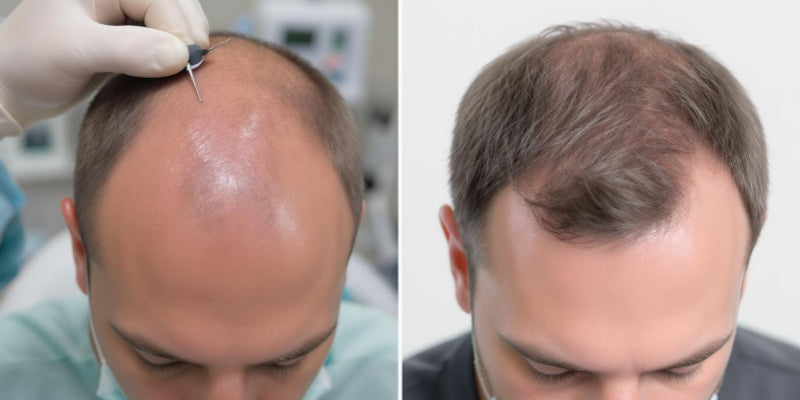
Hair Transplant Procedure Timeline vs. Same-Day Hair System Transformation
Hair Transplant Procedure Timeline vs. Same-Day Hair System Transformation
When you search “hair transplant procedure” or “hair transplant near me,” you’ll find detailed clinic pages outlining consultations, graft counts, and recovery expectations. That information is useful — but it rarely highlights the full time cost, uncertainty, and lifestyle impact. This article maps both journeys in practical terms so you can choose the one that fits your schedule, budget, and appearance goals.
Surgical Timeline — Step by Step
1. Initial Consultation & Planning (0–2 weeks)
Most clinics (from a local hair transplant clinic to well-known centers like those in the hair restoration network) start with medical history, photos, donor area assessment, and graft planning. If you search “mens hair transplant near me,” you’ll often be booking this as a separate visit.
2. Pre-Op Preparation (1–4 weeks)
Pre-op can include blood tests, medication changes (e.g., stop blood thinners), and logistical planning. Some surgeons require pre-treatment with topical or oral drugs to improve graft survival.
3. Surgery Day (1 day — 4–8+ hours)
Whether it’s FUE or FUT hair transplant, the operation itself can last many hours. Local anesthesia is used; you’re awake but may be fatigued afterward. If you’re comparing clinics or even the “best hair transplant in the world,” the duration is similar for large graft counts.
4. Early Recovery (0–2 weeks)
Expect scabbing, tenderness, and strict aftercare instructions. You’ll often be advised to avoid strenuous exercise and sun exposure. Many patients take time off work at this stage.
5. Shedding Phase (2–12 weeks)
It’s normal for transplanted hairs to shed before regrowing. This period is emotionally difficult for some — you may look no better (or worse) than before.
6. Regrowth (3–9+ months)
Visible regrowth starts around 3–6 months; final density and naturalness may take 9–12 months. And if the donor supply was limited, additional sessions may be needed to reach desired density.
What to Expect Post-Op: Practical Considerations
- Follow-up visits for graft checks and potential touch-ups.
- Possible prescription medications (minoxidil, finasteride) to protect native hair.
- Scarring: FUT leaves a strip scar; FUE leaves many small dot scars.
- Uncertainty: even at reputable centers, graft survival rates vary.
Same-Day Hair System: The Timeline
Contrast that with a modern hair system (especially ultra thin skin bases):
1. Consultation & Measurements (Same day or remote)
Most providers perform a brief consultation — sometimes remotely — then take head measurements and photos for custom matching.
2. Color & Density Match + Production (Hours–Days)
For stock units, match & fit can be done same day. For fully customized units, production may take days — but many high-quality shops stock popular configurations for near-instant delivery.
3. Fitting & Attachment (1–3 hours)
A trained stylist or technician can apply an ultra thin skin system in a single session. No anesthesia, no incisions.
4. Walk Out That Same Day
No recovery. No visible scabs. You leave with full density and a flawless hairline. If you search “non surgical hair replacement near me,” you’ll find local installers — but many brands ship worldwide so you aren’t forced to rely on a nearby shop.
Side-by-Side Time Comparison
| Stage | Hair Transplant (FUE/FUT) | Ultra Thin Skin Hair System |
|---|---|---|
| Consultation to treatment | 1–4 weeks | Same day — or remote consultation |
| Procedure duration | 1 day (4–8+ hours) | 1–3 hours for fitting |
| Recovery | 2–12 weeks (sensitivity, scabs) | None |
| Final visible results | 6–12+ months | Immediate |
Who Should Consider Which Option?
Consider a hair transplant if:
- You want permanent biological hair back and have adequate donor supply;
- You accept long recovery and the possibility of multiple sessions;
- You are prepared for the time & emotional investment of the regrowth process.
Consider a hair system if:
- You need immediate results (e.g., upcoming events, camera work);
- You want flexibility to change density or style frequently;
- You want to avoid surgical risks, scars, and long waiting windows;
- You searched “hair replacement near me” and want options beyond local, often limited stock solutions.
Maintenance, Lifespan & Practical Care
Surgical hair requires minimal “attachment” maintenance but does need medication and time to protect native follicles. Hair systems require scheduled maintenance but give predictable appearance:
- Ultra thin skin system care: gentle cleansing, adhesive care, and professional reattachment approximately every 4–8 weeks depending on method.
- Lifespan: High-quality systems last several months up to a year depending on wear and care; base replacements and re-knots extend life.
- Costs: systems are typically far cheaper upfront than many transplant options (see related posts on hair transplant price and Bosley hair restoration cost comparisons).
FAQ
Q: Can a hair system damage my existing hair?
A: When applied correctly (professional bonding and breathable base like ultra thin skin), a hair system will not damage native hair. Proper removal technique is crucial.
Q: Will people notice a hair system?
A: High-quality ultra thin skin bases and correct color/density matching are virtually undetectable—even under bright light—far outperforming many local “hair replacement near me” stock units.
Product Recommendation & CTA
Angelremy Ultra Thin Skin Hair System
Instant coverage, realistic scalp appearance, custom density and color matching. Ideal for crown coverage, receding hairline camouflage, and anyone who can’t wait months for surgical results.
Shop Hair Systems Now







